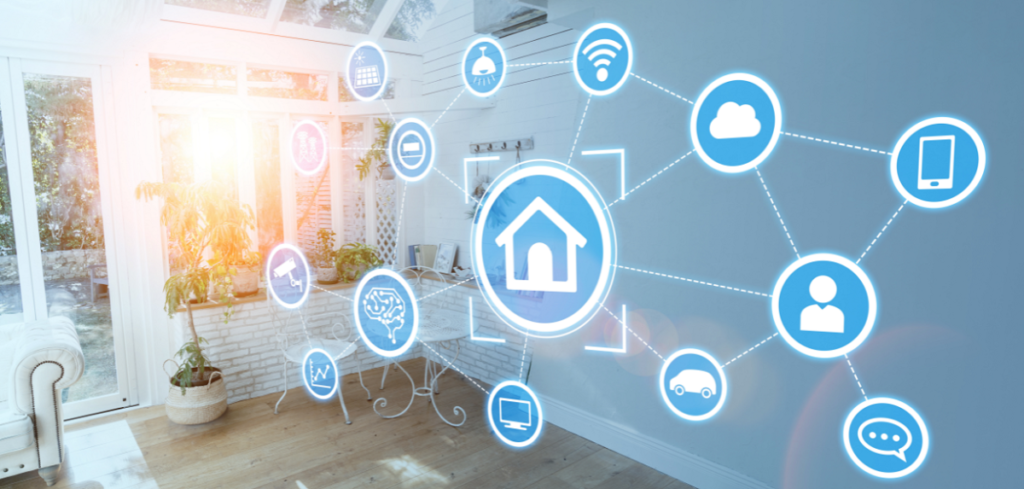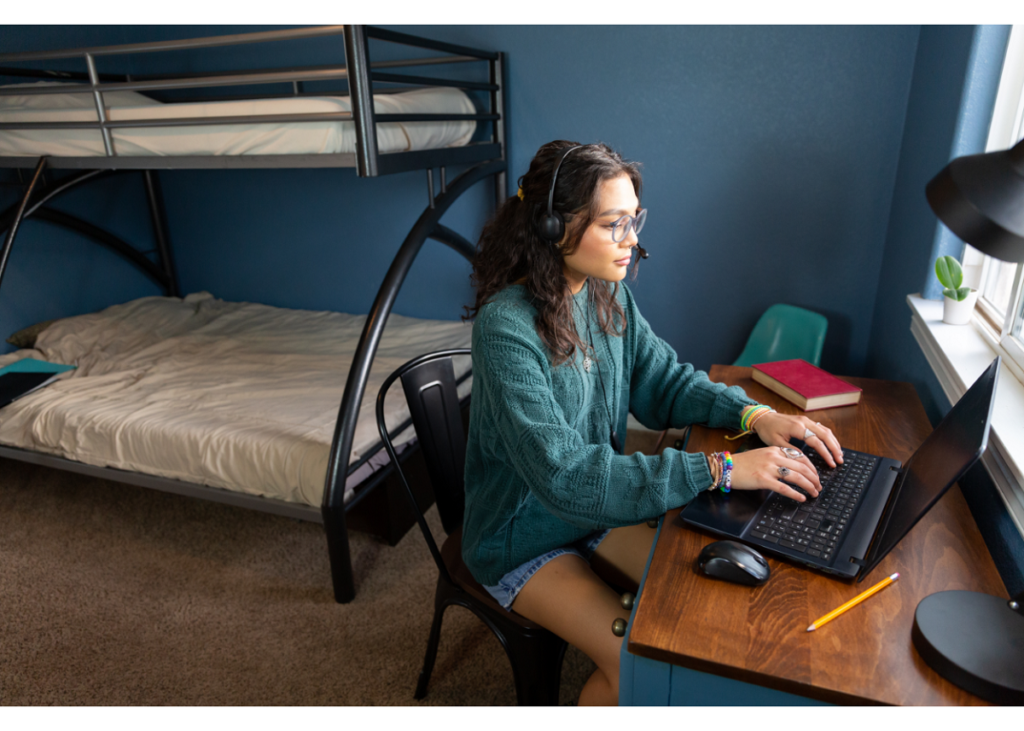Table of Contents
- Not Just the Same Old Dorm
- 1. Ubiquitous connectivity is a must-have
- 2. Access controls offer safety and convenience
- 3. Smart solutions: Green, cost-effective, and personalized
- 4. Entertainment content brings community
- 5. Digital signage: What’s going on?
- 6. EV charging supports sustainability
- 7. VR/AR: Show them what you’ve got
- Things to Consider
- Here are some helpful links to learn more
Not Just the Same Old Dorm
Both on- and off-campus, the nature of student housing is changing. Instead of bleak collections of impersonal rooms on endless hallways, dorms and student apartments are becoming more like mixed-use housing, either self-contained on campus or within larger communities. Students are looking for places where they can study, collaborate, relax, and engage, along with the amenities to support their daily activities.
To remain competitive, universities and owners of student housing properties need to incorporate the things students are looking for, including these seven in-demand technologies:
1. Ubiquitous connectivity is a must-have
Modern technology is connected technology; thus, digital infrastructure, including WiFi, is a fundamental requirement. Not only do students need WiFi that’s accessible everywhere all the time, but any other technology that you offer to students will also necessitate good connectivity. Without it, you can offer all kinds of new technologies, but they won’t perform well, leading to a worse experience for residents.
You need to be sure that your WiFi is easy to connect to and that it’s fast, reliable, and high-performing. This means the underlying circuit must also perform well and have enough capacity. Be sure to upgrade your equipment periodically to support the newer phones and other devices that students will be using.
Also, make sure that you’ve got enough Internet bandwidth to handle the traffic from students’ devices and various amenities. A typical American now has access to 10 devices on average. As the number of devices (and the traffic to and from those devices) increases, there is a need for greater bandwidth to support consistently good performance. It’s commonly recommended that your connection support 25Mbps downstream per device at a minimum. However, if your residents are using OTT content, streaming, casting, gaming, videoconferencing, and other high-bandwidth activities, you’ll want to double or triple that estimate.
You’ll also want to consider a managed WiFi solution that ensures consistent quality of service (QoS) through bandwidth shaping and other techniques designed to avoid outages, slow speeds, buffering, and other complaints. Managed WiFi solutions also offer expert ongoing monitoring, maintenance, and support that will relieve staff of these tasks.
2. Access controls offer safety and convenience
Student housing operators want to ensure that their residents are safe. One way to do this is to implement modern access controls. Mobile room keys using options such as NFC, RFID, or Bluetooth allow for remote configuration and management, reduce operating costs, and improve the security of your entire property. They’re also a convenient option for residents who don’t have to carry a physical key. However, you’ll need to be sure you have a backup option, for example, if a guest’s phone dies and they can’t use it to enter their room.
Access control solutions can also include CCTV cameras to keep an eye on your entire property. With AI-assisted solutions, systems can flag unusual and suspicious activity, such as someone lingering in an unauthorized area.
Video intercoms provide another layer of safety, letting residents and staff know who’s trying to access the building.
Access controls can also be applied to package delivery, for example, by implementing lockers with Bluetooth or app-connected access to offer security and convenience.

3. Smart solutions: Green, cost-effective, and personalized
For modern students, sustainability is essential. Students tend to be knowledgeable about environmental impacts, and they expect consideration of those impacts when they choose whom to do business with – including their housing. From building materials to operating choices, being green is important.
Smart solutions can play an important role in making student housing greener. Internet of Things (IoT)-based technology enables more efficient energy use through automation. For example, sensors and actuators can adjust lighting and temperature automatically when no one is in a room. Likewise, leak and water sensors can detect potential plumbing problems before they result in significant issues.
Not only can smart solutions improve efficiency, but they can also lower the cost of energy use, and they offer options for personalization. Residents in many types of housing appreciate the ability to personalize spaces to meet their needs and preferences, such as by setting their own lighting, temperature, music, and other aspects of their environment. If students can make these adjustments using their own phones, such as via Bluetooth, so much the better for ease and convenience.
4. Entertainment content brings community
Aside from providing TVs in common rooms and adding a pool table, many options are available to encourage students to come together in common areas to develop a community. For example, providing entertainment options such as over-the-top (OTT) content, streaming, and casting can help students share in a common experience. Game consoles offer a good way to blow off steam together and relax from the stresses of college.
Property owners can also support students’ use of technology in creative ways. For example, consider providing a green screen, configurable lighting, and basic recording equipment. These items can help students participate in creating video content and podcasts. Students may also appreciate the availability of collaborative spaces in which they can study and use technology together.
Larger communities might consider creating outdoor spaces for wellness activities such as yoga and meditation and popular sports like pickleball. Technology can also be used to determine how best to outfit a property. Occupancy sensors and tracking systems can help owners learn what amenities are used most. Does the gym need more or less equipment? Is the rec room crowded at certain times of day? Data gathering combined with AI-powered analysis can help you figure out what your residents are looking for and where it makes sense to invest.
Don’t neglect the details either – with all the devices that students inevitably bring, you’ll need to offer plenty of outlets and perhaps also charging stations in common areas.

5. Digital signage: What’s going on?
For college students, there’s a lot of information to keep track of, and it’s easy to miss announcements. Digital signage provides a modern and flexible way to reach student housing residents and keep them informed, increasing resident satisfaction while also creating revenue opportunities for owners.
Configurable displays can show calendars of upcoming events and deadlines, directory information, and more. Owners can partner with businesses such as restaurants or local attractions to promote special offers for students. Digital signage can even make student housing a more enjoyable and inviting place to be by presenting displays of student artwork and videos. And digital signage can be more environmentally friendly by replacing countless paper flyers.
Digital signage can also generate revenue for property owners. For example, local businesses may be willing to pay for digital ads or events calendar placement or to sponsor other digital display content. Signs can display “sizzle reels” for upcoming special events or to highlight paid services and amenities. With the ability to program content dynamically, the type of content can change based on time of day, weather or season, and more, yielding greater potential for targeting revenue-generating content.
6. EV charging supports sustainability
As more people buy electric vehicles, mixed-use housing communities are starting to advertise the availability of charging stations. UBS Bank forecasts that, by 2025, 20 percent of all new cars sold globally will be electric. The US Department of Energy has supported provisions to require developers of new MDUs to provide EV chargers for at least 20% of parking spaces in larger communities.
As the demand for electric vehicles soars, EV chargers have become a sought-after amenity. Thus, adding these chargers to your student housing property may improve your ratings, gain attention from prospective residents, and even allow you to increase your rental rates. Making EV chargers available will also highlight your commitment to green initiatives and can even add LEED certification points to your property.
7. VR/AR: Show them what you’ve got
Gone are the days when students started their college adventure by stepping into an apartment after renting it sight unseen. Savvy residents now expect to know exactly what they’ll get when choosing their next living space. While a website can provide basic information, property owners can better showcase their offerings by using virtual reality (VR) and augmented reality (AR) technology. Both VR and AR provide ways for prospective residents to step into a dorm or apartment community and really feel like they could live there. From showing off the apartment space to highlighting the available common areas and amenities, VR and AR can help boost your property above the competition.
Things to Consider
With connected technologies, it’s always crucial to consider the privacy and security of the data that’s being transmitted. Be sure to implement a plan to keep your network safe. Managed solutions from established vendors can help address this.
Also, be sure to consider the importance of a personalized experience that’s not only high-tech but also the right amount of high-touch. While students tend to prefer electronic communications and self-service options, there will be times when they’ll appreciate having some personal assistance and someone who can help them handle an issue. Tech solutions can be a differentiator for your property, but so can great personal service.

